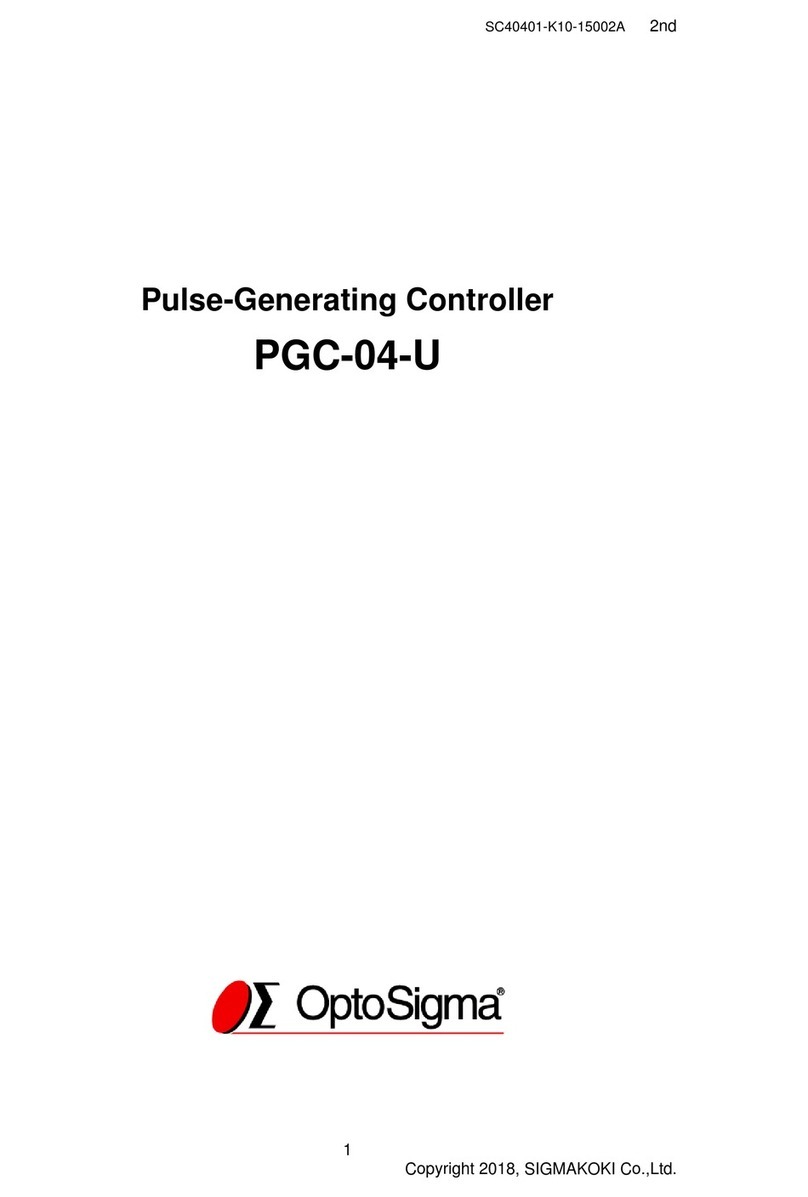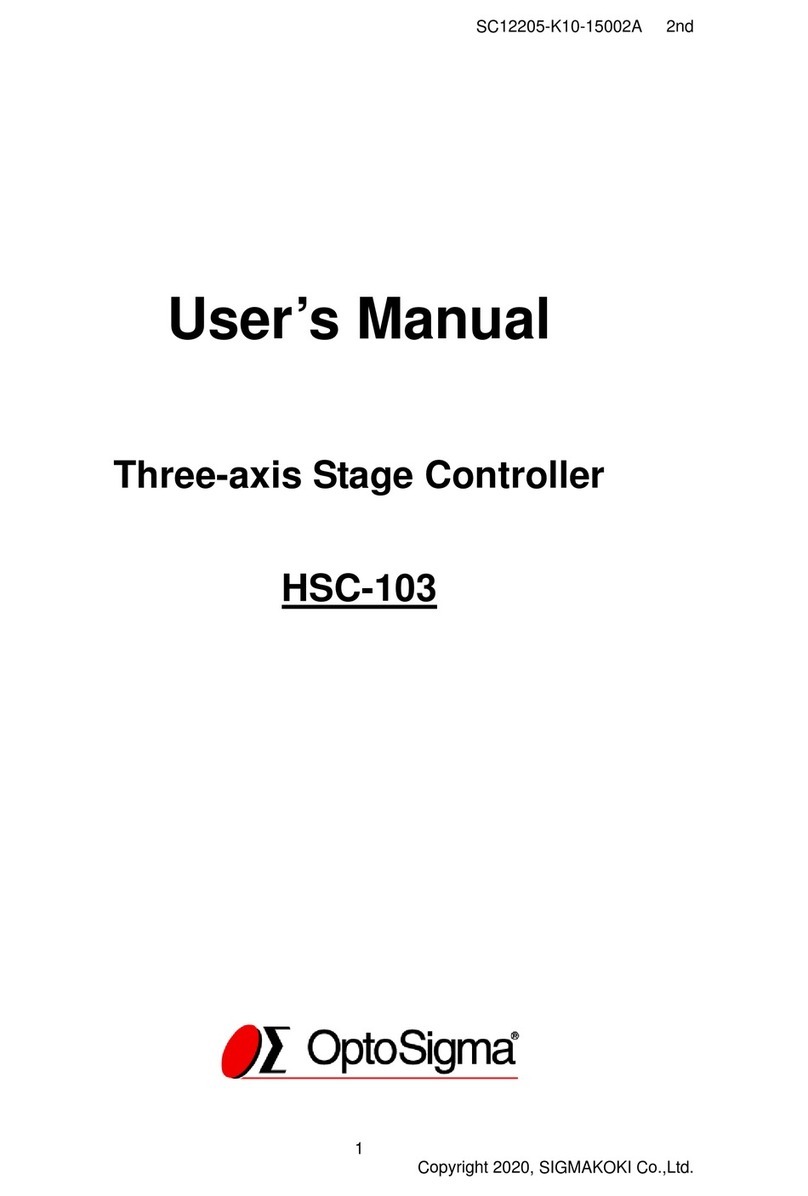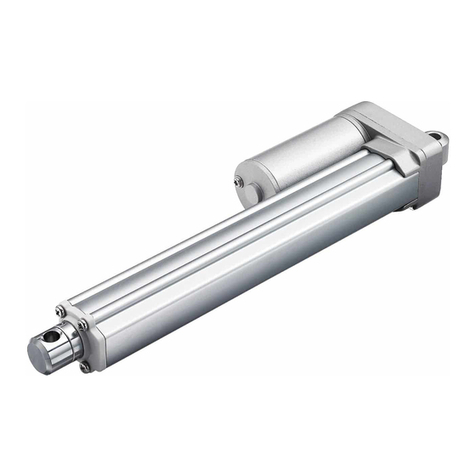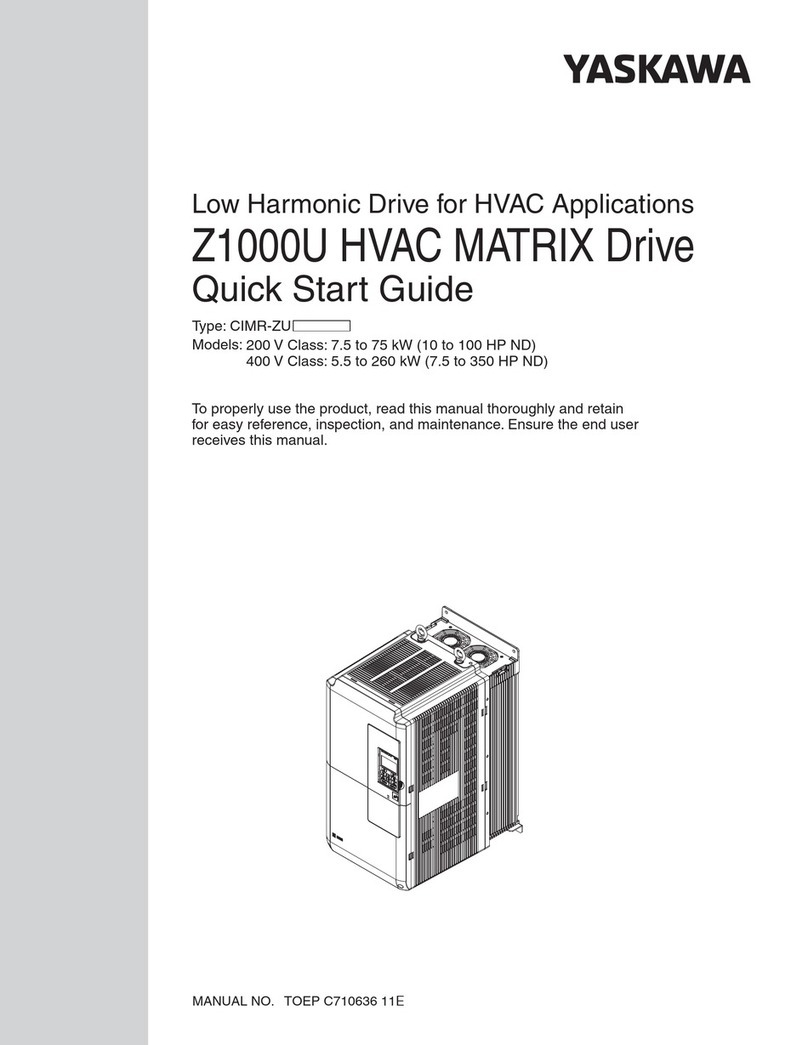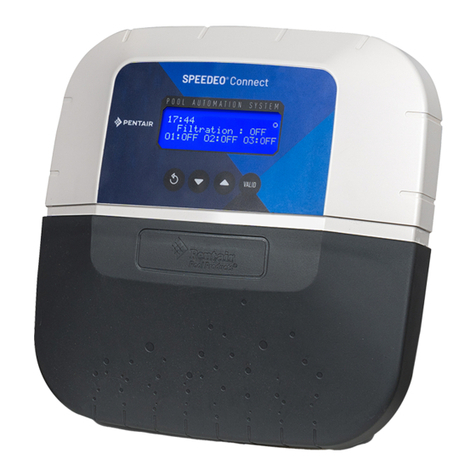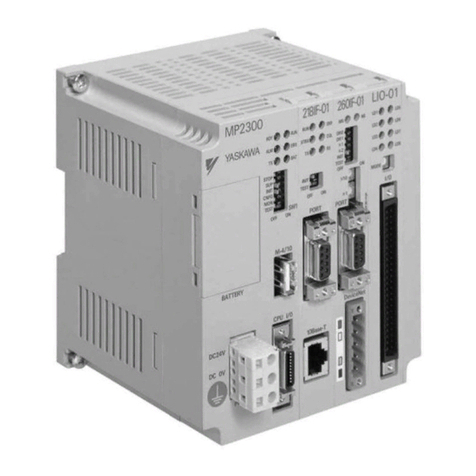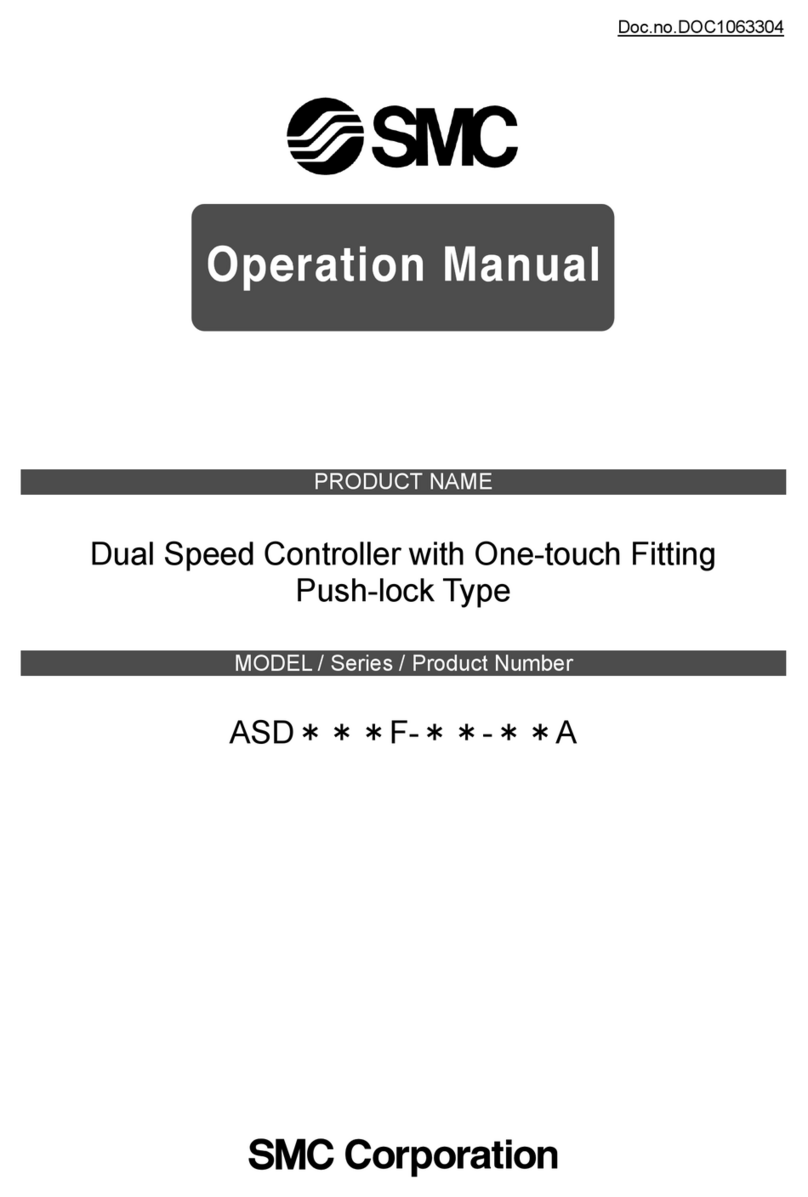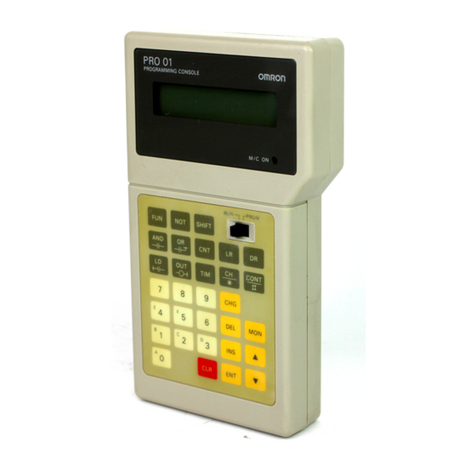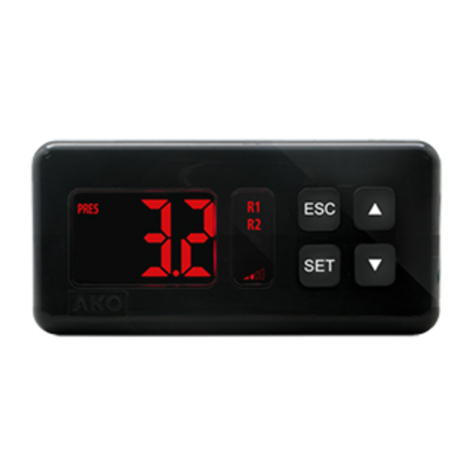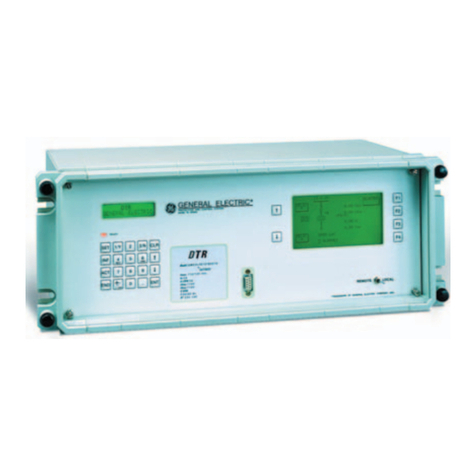SIGMAKOKI HIT-M User manual

1
Copyright 2018, SIGMAKOKI Co.,Ltd.
User’s Manual
Link controller for multi-axes stages
HIT-M / HIT-S / HIT-SH

2
Copyright 2018, SIGMAKOKI Co.,Ltd.
Notes regarding these materials
・ These materials are intended as a reference to assist our customers in the use of the
SIGMAKOKI CO., LTD. Product best suited to the customer’s application; they do not
convey any license under any intellectual property rights, or any other rights, belonging to
SIGMAKOKI CO., LTD. or a third party.
・ SIGMAKOKI CO., LTD. assumes no responsibility for any damage, or infringement of any
third-party’s rights, originating in the use of any product data, diagram, charts, programs, or
algorithms contained in these materials.
・ All information contained in these materials, including product data, diagrams, charts,
programs and algorithms represents information on products at the time of publication of
these materials, and are subject to change by SIGMAKOKI CO.,LTD. without notice due to
product improvements or other reasons.
・ When using any or all of the information contained in these materials, including product
data, diagrams, charts, programs, and algorithm, please be sure to evaluate all information
and products. SIGMAKOKI CO., LTD. assumes no responsibility for any damage, liability or
other loss resulting from the information contained herein.
・ SIGMAKOKI CO., LTD. products are not designed or manufactured for use in equipment or
system that is used under circumstances in which human life is potentially at stake.
SIGMAKOKI CO., LTD. products cannot be used for any specific purposes, such as
apparatus or systems for transportation, vehicular, medical, aerospace, nuclear, or
undersea repeater use.
・ The prior written approval of SIGMAKOKI CO., LTD. is necessary to reprint or reproduce in
whole or in part these materials.
・ If these products or technologies are subject to the Japanese export control restrictions,
they must be exported under a license Japanese government and cannot be imported into
a country other than the approved destination.
Any diversion or re-export contrary to the export control laws and regulations of Japan and/
or the country of destination is prohibited.

3
Copyright 2018, SIGMAKOKI Co.,Ltd.
Contents
For Your Safety
For Your SafetyFor Your Safety
For Your Safety ..................................................... 4
Chapter 1:
Chapter 1: Chapter 1:
Chapter 1: Before You Begin
Before You BeginBefore You Begin
Before You Begin ......................................... 6
1
11
1-
--
-1.Package Contents
1.Package Contents1.Package Contents
1.Package Contents ............................................................................................................................................................... 6
1
11
1-
--
-2.
2.2.
2.Overview
OverviewOverview
Overview ................................................................................................................................................................................. 6
1
11
1-
--
-3.HIT
3.HIT3.HIT
3.HIT-
--
-M, HIT
M, HITM, HIT
M, HIT-
--
-S,HIT
S,HITS,HIT
S,HIT-
--
-SH System Diagram
SH System DiagramSH System Diagram
SH System Diagram .................................................................................................................... 7
1
11
1-
--
- .Parts and Functions
.Parts and Functions.Parts and Functions
.Parts and Functions ........................................................................................................................................................... 8
Chapter 2: Connection Flow
Chapter 2: Connection FlowChapter 2: Connection Flow
Chapter 2: Connection Flow ......................................... 11
2
22
2-
--
-1.
1.1.
1.Connection between HIT
Connection between HITConnection between HIT
Connection between HIT-
--
-S or HIT
S or HITS or HIT
S or HIT-
--
-SH and motorized stage
SH and motorized stageSH and motorized stage
SH and motorized stage ....................................................................... 11
2
22
2-
--
-2.
2.2.
2.Interface between HIT
Interface between HITInterface between HIT
Interface between HIT-
--
-M and HIT
M and HITM and HIT
M and HIT-
--
-S(HIT
S(HITS(HIT
S(HIT-
--
-SH)
SH)SH)
SH) .................................................................................................... 11
2
22
2-
--
-3.Interface with PC
3.Interface with PC3.Interface with PC
3.Interface with PC ............................................................................................................................................................. 12
2
22
2-
--
- .Power Supply
.Power Supply.Power Supply
.Power Supply ..................................................................................................................................................................... 12
Chapter 3: Settings
Chapter 3: SettingsChapter 3: Settings
Chapter 3: Settings ................................................ 13
3
33
3-
--
-1.Settings Motor Driving Current
1.Settings Motor Driving Current1.Settings Motor Driving Current
1.Settings Motor Driving Current .................................................................................................................................. 13
3
33
3-
--
-2.
2.2.
2. Settings Motor Divide
Settings Motor DivideSettings Motor Divide
Settings Motor Divide ................................................................................................................................................... 14
3
33
3-
--
-3.Memory Switch settings
3.Memory Switch settings3.Memory Switch settings
3.Memory Switch settings ................................................................................................................................................ 15
3
33
3-
--
- .Memory Switch contents list and detailed settings
.Memory Switch contents list and detailed settings.Memory Switch contents list and detailed settings
.Memory Switch contents list and detailed settings ........................................................................................... 15
3
33
3-
--
-5.LAN settings
5.LAN settings5.LAN settings
5.LAN settings ...................................................................................................................................................................... 29
Chap
ChapChap
Chapter 4: Feature
ter 4: Featureter 4: Feature
ter 4: Feature ................................................. 31
-
--
-1.HIT mode command
1.HIT mode command1.HIT mode command
1.HIT mode command ........................................................................................................................................................ 31
-
--
-2.SHOT mode command
2.SHOT mode command2.SHOT mode command
2.SHOT mode command ................................................................................................................................................... 46
-
--
-3.Program functions
3.Program functions3.Program functions
3.Program functions ............................................................................................................................................................ 58
-
--
-
.Origin Reset Setting
.Origin Reset Setting.Origin Reset Setting
.Origin Reset Setting ....................................................................................................................................................... 61
-
--
-5.Emergency STOP
5.Emergency STOP5.Emergency STOP
5.Emergency STOP ............................................................................................................................................................. 65
Chapter 5: Rotation Stage
Chapter 5: Rotation StageChapter 5: Rotation Stage
Chapter 5: Rotation Stage .......................................... 66
5
55
5-
--
-1.HIT mode
1.HIT mode1.HIT mode
1.HIT mode ............................................................................................................................................................................. 66
5
55
5-
--
-2.SHOT Mode [Close loop control]
2.SHOT Mode [Close loop control]2.SHOT Mode [Close loop control]
2.SHOT Mode [Close loop control] .............................................................................................................................. 67
Chapter 6: Specifications
Chapter 6: SpecificationsChapter 6: Specifications
Chapter 6: Specifications .......................................... 68
6
66
6-
--
-1.Specifications
1.Specifications1.Specifications
1.Specifications .................................................................................................................................................................... 68
6
66
6-
--
-2.Connector Pin Assignments
2.Connector Pin Assignments2.Connector Pin Assignments
2.Connector Pin Assignments ........................................................................................................................................ 70
6
66
6-
--
-3.Outlines
3.Outlines3.Outlines
3.Outlines ................................................................................................................................................................................ 72

4
Copyright 2018, SIGMAKOKI Co.,Ltd.
For Your Safety
Before using this product, read this manual and all warnings or cautions in the documentation provided.
Only Factory Authorized Personnel should be changes and/or adjust the parts of controller.
The Symbols Used in This Manual
! WARNING ! CAUTION
This symbol marks warnings that should be read
and used to prevent serious injury or death.
This symbol indicates where caution should be used
to avoid possible injury to yourself or others, or
damage to property.
The above indications are used together with the following symbols to indicate the exact nature of the warning or
caution.
Examples of Symbols Accompanying Warnings and Cautions
△Symbols enclosed in a triangle indicate warnings and cautions. The exact nature of
the warning or caution is indicated by the symbol inside (the symbol at left indicates
risk of electrocution).
○Symbols enclosed in a circle mark indicate prohibitions(actions that must not be
performed).The exact nature of the prohibition is indicates by the symbol inside or
next to the circle mark (the symbol at left indicates that the product must not be
disassembled).
●Symbols inside a black circle mark actions that must be performed to ensure safety.
The exact nature of the action that must be performed is indicated by the symbol
inside (the symbol at left is used in cases in which the AC adapter must be unplugged
to ensure safety).
Symbols on the product
The symbol mark on the product calls your attention. Please refer to the manual, in the case that you operate the part
of the symbol mark on the product.
!
This symbol labeled on the portion calls your attention.

5
Copyright 2018, SIGMAKOKI Co.,Ltd.
Disclaimer of Liability
① SIGMAKOKI CO., LTD. does not accept liability for damages resulting from the use of this product or the inability
to use this product.
② SIGMAKOKI CO., LTD. does not accept liability for damages resulting from the use of this product that deviates
from that described in the manual.
③ SIGMAKOKI CO., LTD. does not accept liability for damages resulting from the use of this product in
extraordinary conditions, including fire, earthquakes, and other acts of God, action by any third party, other
accidents, and deliberate or accidental misuse.
④ If the equipment is used in a manner not specified by the SIGMAKOKI CO., LTD., the protection provided by the
equipment may be impaired.
WARNING
●Do not use this product in the presence of flammable gas, explosives, or corrosive substances, in areas exposed
to high levels of moisture or humidity, in poorly ventilated areas, or near flammable materials.
●Do not connect or check the product while the power is on.
●Installation and connection should be performed only by a qualified technician.
●Do not bend, pull, damage, or modify the power or connecting cables.
●Do not touch the products internal parts.
●Connect the earth terminal to ground.
●Should the product overheat, or should you notice an unusual smell, heat, or unusual noises coming from the
product, turn off the power immediately.
●Do not turn on the power in the event that it has received a strong physical shock as the result of a fall or other
accident.
●Do not touch the stage while operation.
●Use dry clothes only for cleaning the equipment.
!

6
Copyright 2018, SIGMAKOKI Co.,Ltd.
Chapter 1: Before You Begin
1-1.Package Contents
Purchasers of the Stage Controller should find that the package contains the items listed below. Check the package
contents using the following checklist. Contact your retailer as soon as possible in the event that you should find that
any item is missing or damaged.
As HIT-M or HIT-S or HIT-SH is selling individually, please take care of this point when you purchase.
1-2.Overview
This controller is a Multi-Axes Moterized Stage Controller built in 5 Phase stepping motor Driver (Maximum 8 axes’
connection possible). Since micro-step driver is installed, it is possible to be done with high resolutional operation
and positioning.
When HIT-M is connected to an ordinary personal computer via an RS232C, USB or LAN interface, the stage can
be accurately moved to the desired position by simple commands sent from the PC.
HIT-S set
□HIT-S Stage Controller
□LAN Cable (0.6m)
HIT-M set
□HIT-M Stage Controller
□User’s Manual (This Manual)
Option
□PAT-POW (DC24V Power Supply)
HIT-SH set
□HIT-SH Stage Controller
□LAN Cable (0.6m)

7
Copyright 2018, SIGMAKOKI Co.,Ltd.
1-3.HIT-M, HIT-S,HIT-SH System Diagram
(*) In case of connection between PC and HIT-H directry please use cross cable, and in case of connection
through HUB please use straight cable.
HIT-M
RS232C cable
USB cable
LAN cable(*1)
Control
from PC
HIT-SH(Stepping motor specifications)
Exe) HST serise
D15D15A cable
D15D15A-CA
External I/O control
Please interface with 10120-3000PE
by 3M Limited.
(*1) Please use a crossover cable when directly
Connecting HIT-M to PC. And a straight cable
When connecting through a HUB.
HIT-S HIT-SH
LAN cable
(straight)
Scale cable
GSEF-CA
HIT-SH(Scale compatible GS series)
Exe) HST(GS) serise
D15D15A cable
D15D15A-CA
or
D15RP cable
D15RP-CA
HIT-S (Stepping motor specifications)
Exe) OSMS/OSMS-ZF/TAMM/HPS/HDS/
OSMS-YAW/OSMS-Gonio/SGSP-ACT series
HIT-S (Scale compatible CS series)
Exe) OSMS(CS) series
D15D15A cable
D15D15A-CA
Scale cable
GSEF-CA
D15D15A cable
D15D15A-CA

8
Copyright 2018, SIGMAKOKI Co.,Ltd.
1-4.Parts and Functions
HIT-M Front Panel
1) 7 Segment LED : When Power (DC24V) is supplied, it shows No.of axis connected for approx.4
seconds, then dot in LED box flashes.
2) Emergency Stop Connector : It connects with Emergency Stop Switch. Please refer to「4-5 Emergency STOP」
for further details.
3) I/O Connector : It interfaces with input/output signal for external devices.
4) Power Supply Terminal : Supply Power (DC +24V 1A)
5) FG Terminal : It is Terminal for Frame Ground. Please connect to Earth in the actual
environment.
6) RS232C Connector : When control by RS232C Interface through PC, please use RS232C.
7) USB Connector : When control by USB Interface trough PC, please use USB.
8) LINK Connector :In case of connection between HIT-M and HIT-S and HIT-SH, connect with using
attached straight LAN cable.
9) ETHERNET Connector : In case of connection through Ethernet from PC, connect with using straight or
cross LAN cable.
4) Power Supply Terminal
1) 7Seg LED
7) USB Connector
6) RS232C Connector
2) Emergency STOP Connector
3) I/O Connector
5)
FG Terminal
9) ETHERNET Connector
8) LINK Connector
Make sure to set up and wire the cable supplying DC+24V and FG_GND to the HIT-M so
that the maximum length of cable is not longer than 2m.
For your own safety, make sure POWER is OFF before connecting every cable.

9
Copyright 2018, SIGMAKOKI Co.,Ltd.
HIT-S Front Panel
1) INDICATOR LED : Shows the HIT-S condition. When it is booted with no fault, LED flashes. In case of
fault-booting, LED light is on.
2) No.Switch : Sets the HIT-S address. Please refer to 「2-2 Interface between HIT-M and
HIT-S(HIT-SH)」for further details.
3) END Switch : Sets the terminating node. Please refer to 「2-2 Interface between HIT-M and
HIT-S(HIT-SH)」for further details.
4) Scale Connector : Connects to the cable attached to the Glass Scale in use.
5) LINK Connector : Connects to a straight LAN cable, for connecting HIT-M and HIT-S and HIT-SH.
6) RUN Potentiometer : The current delivered when the motor is moving can be set by adjusting RUN
potentiometer above. Please refer to 「3-1 settings for motor driving current」for further
details.
7) STOP Potentiometer : The current delivered when the motor is stopped can be set by adjusting STOP
potentiometer above. Please refer to 「3-1 settings for motor driving current」for further
details.
8) Connector for Stage Driver : Connects to the cable attached to the motorized stage in use.
9) Power Supply Terminal :DC +24V 1A Power Supply
10) FG Terminal :Frame Ground Terminal. Please connect to EARTH when using.
9) Power Supply Terminal
6)RUN Potentiometer
2) No. of Switch
7) STOP Potentiometer
8) Connector for Stage Driving
10) FG Terminal
4) Scale Connector
3) END Switch
5) LINK Connector
1) INDICATOR LED
Make sure to set up and wire the cable supplying DC+24V and FG_GND to the HIT-S so
that the maximum length of cable is not longer than 2m.
For your own safety, make sure POWER is OFF before connecting every cable.

10
Copyright 2018, SIGMAKOKI Co.,Ltd.
HIT-SH Front Panel HIT-SH Top Panel
1) INDICATOR LED : Shows the HIT-SH condition. When it is booted with no fault, LED flashes. In case of
fault-booting, LED light is on.
2) No.Switch : Sets the HIT-SH address. Please refer to「2-2.Interface between HIT-M and
HIT-S( HIT-SH)」for further details.
3) END Switch : Sets the terminating node. Please refer to 「2-2.Interface between HIT-M and
HIT-S(HIT-SH)」for further details.
4) Scale Connector : Connects to the cable attached to the Glass Scale in use.
5) LINK Connector : Connects to a straight LAN cable, for connecting HIT-M and HIT-S and HIT-SH.
6) Connector for Stage Driver : Connects to the cable attached to the motorized stage in use.
7) Power Supply Terminal :DC +24V 2A Power Supply
8) FG Terminal :Frame Ground Terminal. Please connect to EARTH when using.
9)STEP Seitch :
Sets the motor step angle. Please refer to「3-2.Settings Motor Divide」for
further details.
7) Power Supply Terminal
9) STEP Switch
6) Connector for Stage Driving
8
)
FG Terminal
2) No. of Switch
4) Scale Connector
3) END Switch
5) LINK Connector
1) INDICATOR LED
Make sure to set up and wire the cable supplying DC+24V and FG_GND to the HIT-SH
so that the maximum length of cable is not longer than 2m.
For your own safety, make sure POWER is OFF before connecting every cable.

11
Copyright 2018, SIGMAKOKI Co.,Ltd.
Chapter 2: Connection Flow
2-1.Connection between HIT-S or HIT-SH and motorized stage
First, connect HIT-S or HIT-SH and every mtorized stage. Here it shows the case that OSMS(CS)20-35(X) with
built in compact scale is connected to HIT-S.
①Connect the connector (D-sub connector 15p) of OSMS(CS)20-35(X) with standard cable(D15D15A-CA)
②Connect the connector of “STAGE” of FRONT Panel with the other side of standard cable (D15D15A-CA)
connected to OSMS(CS)20-35(X) in No.1 procedure.
③Connect tne scale connector of OSMS(CS)20-35(X) with standard cable (GSEF-CA)
④Connect the scale connector defeat “SCALE” of FRONT Panel with the other side of standard cable
(GSEF-CA) connected to OSMS(CS)20-35(X) in No.3 procedure.
2-2.Interface between HIT-M and HIT-S(HIT-SH)
(1) How to connect HIT-M and HIT-S(HIT-SH)
Here it shows the case that HIT-M is connected to HIT-S. In the case of HIT-SH, it is the same.
Please connect HIT-M LINK connector and HIT-S LINK connector (address 0) with
straight LAN cable . When 2 axes are in need, which means 2 HIT-S are being used, please connect a LINK
connector on 1st HIT-S (address 0) and the other LINK connector on 2nd HIT-S (address 1) with straight
LAN cable.
(2) No. Switch
Up to 8 stages, numbered from 0 to 7, can be controlled by setting address No.s of HIT-S(HIT-SH) with No.Switch.
(3) Terminating node
Please set terminating node by switching on END.Switch in HIT-S (HIT-SH).
*) When a stand (more than two) displays plural HIT-M/HIT-S/HIT-SH and installs it, please keep it away more
than 20mm to a horizontal direction and vertical directions.
More than 20mm
More than 20mm

12
Copyright 2018, SIGMAKOKI Co.,Ltd.
2-3.Interface with PC
(1) RS232C Connection
Please connect by using RS232C (RS232C/STR) cable. In this case, please set the memory switch (Interface) to
RS232C.
(2) USB Connection
Please connect by using USB cable. In this case, please set the memory switch (Interface) to USB.
(3) LAN connection
Please connect by using LAN crossover cable (LAN-CA). However, please use straight LAN cable when
connecting via HUB. Then, set Memory Switch (INTFACE) to Ethrnet.
[192.168.0.1] and [255.255.255.0] are set as default value for IP address of HIT-M and Subnet Mask respectively.
Please set IP address for PC to [192.168.0.X] (X can be any number from 0 to 255.) and Subnet Mask
[255.255.255.0] in order for PC to be able to communicate with HIT-M. With regard to LAN settings for HIT-M,
please refer to「3-4 LAN Settings」.
2-4.Power Supply
Power supply should be done as instructed below. Use DC24V for everything of HIT-M,HIT-S,HIT-SH
① First, switch HIT-S and HIT-SH on.
② Next, switch HIT-M on. 7 Seg LED on HIT-M will show the No. of axis of connected HIT-S and HIT-SH. to
HIT-M for approx. 4 seconds, and dot in LED will start to flicker.
(Please ensure to follow the Power Supply order instructed above, because communication between HIT-M and
HIT-S or HIT-SH can not be completed when location of terminating node is unsure.
*Note) They can also be switched on at the same time.
③ When HIT-M is switched on, “INDICATOR” LED on HIT-S flashes.
(”INDICATOR” LED is still lighted when only HIT-S or HIT-SH is switched on, or when fault-interface has been
made between HIT-M and HIT-S or HIT-SH.)
Communication among HIT-M and HIT-S and HIT-SH can be made when ”INDICATOR” LED flashes.
Please switch HIT-M on once again when LED is still lighted.
④Dot in 7Seg LED on HIT-M flashes in good condition.

13
Copyright 2018, SIGMAKOKI Co.,Ltd.
Chapter 3: Settings
3-1.Settings Motor Driving Current
Motor driving current on HIT-S should be set in accordance with stage in use. (RUN/STOP) Potentiometer is on
the front side of HIT-S. (Please refer to Diagram 3-1.)
Diagram 3-1:HIT-S front side
Driving current settings (RUN current)
Driving current can be set with RUN potentiometer. Its factory default is set to 0.75A/Phase.
Pot. Scale 0 1 2 3 4 5 6
RUN current (A/Phase) 0 0.17 0.35 0.66 0.75 0.9 1.1
Stopping current settings (STOP current)
Electric current when the motor is stopped can be set with STOP potentiometer. STOP current is set as a
percentage of the RUN current. Its factory default is set to approx. 50%.
*) STOP current is normally set to approx. 50% of RUN current. (Factory default setting)
Vol. Gradation 0 1 2 3 4 5 6
STOP Current(%) 0 10 21 35 50 60 68
Drive Current Potentiometer Potentiometer

14
Copyright 2018, SIGMAKOKI Co.,Ltd.
3-2.
Settings Motor Divide
Set Motor Divide of HIT-SH.
There is the setting (STEP) switch in the upper surface of HIT-SH.
(Please refer to Diagram 3-2.)
Diagram 3-2:HIT-SH top side
Switch No, 0 1 2 3 4 5 6 7
Motor Divide 1 2 Unusable
4 5 8 10 20
Switch No, 8 9 A B C D E F
Motor Divide 25 40 50 80 100 125 200 250
Setting of the Motor Divide.
Motor Divide can be set with STEP switch. Its factory default is set to 20 Division.
* ) When change Motor Divide, the change of the STEP switch of HIT-SH and the change of the memory switch of
HIT-M is necessary.
*)
The command (S:) is sent from a PC, the Motor Divide can't be changed.
*) When change Motor Divide of HIT-SH, please change the memory switch of HIT-M to the same.
STEP switch
Switch (expansion)

15
Copyright 2018, SIGMAKOKI Co.,Ltd.
3-3.Memory Switch settings
The Memory Switches store the controller settings.
When changing Memory Switch settings use the Sample software (SGSample), which can be downloaded from
http://www.global-optosigma.com/en_jp/software/sample_en.html
3-4.Memory Switch contents list and detailed settings
3-4-1 General
No
Memory Switch contents Setting Range / Select items
Default Value
1 Speed SEL 1 - 4 1
2 Speed 1(S) 1 - 999999999 10000
3 Speed 1(F) 1 - 999999999 100000
4 Speed 1(R) 1 - 1000 200
5 Speed 2(S) 1 - 999999999 30000
6 Speed 2(F) 1 - 999999999 300000
7 Speed 2(R) 1 - 1000 200
8 Speed 3(S) 1 - 999999999 70000
9 Speed 3(F) 1 - 999999999 700000
10 Speed 3(R) 1 - 1000 200
11 Speed 4(S) 1 - 999999999 100000
12 Speed 4(F) 1 - 999999999 1000000
13 Speed 4(R) 1 - 1000 200
14 MODE_SEL SHOT/HIT HIT
15 OUT Level Normal High/Normal Low Normal High
16 LED_ON ON/OFF ON
1) SPEED SEL: Speed selection at Power ON
Select the initial setting Speed No. at Power ON.
[Setting Range] 1 ~ 4
2)~13) Speed 1~4(S)(F)(R): Speed Setting
Set 4 kinds of travel stage Speed (minimum S, maximum F, and acceleration/deceleration time R) at Power ON.
[Setting Range] S:1~500000 (Unit:pulse/s) [SHOT mode]
S:1~999999999 (Unit:0.01µm/s) [HIT mode]
F:1~500000 (Unit:pulse/s) [SHOT mode]
F:1~999999999 (Unit:0.01µm/s) [HIT mode]
R:1~1000 (Unit:ms) [SHOTmode][HITmode]
*) Minimum S values should be set smaller than maximum F at Speed Setting.

16
Copyright 2018, SIGMAKOKI Co.,Ltd.
14) MODE_SEL: Operation mode Settting
Operation mode is set.
[Select Item] SHOT:SHOT mode (Compatible with SHOT-304GS)
HIT:HIT mode
15) OUT Level: I/O Output signal logic Setting
Select Logic (Voltage level) for I/O output signal.
[Select item] Normal High:Hi level (Active low) normally
Normal Low:Lo level (Active High) normally
16) LED_ON: Display setting for 7seg LED on HIT-M and for LED display on HIT-S
Set ON or OFF for 7seg LED on HIT-M and for LED display on HIT-S.
[Select item] ON:Turn ON
OFF:Turn OFF
*) OFF setting for LED is available only at normal condition. At abnormal condition, LED will be light.
3-4-2 INTERFACE
No
Memory Switch contents Setting Range / Select items Default value
1 INTERFACE RS232C / USB / Ethrnet RS232C
2 RS232C_FLOW ON / OFF ON
3 Baudrate 4800/9600/19200/38400/57600 38400
1) INTFACE: Setting for communication Interface
Set communication method with HOST (PC).
[Select items] RS232C:RS232C Interface
USB:USB Interface
Ethrnet:Ethrnet Interface
2) RS232C_FLOW: Flow control setting on RS232C
Specify whether the controller will do flow control in RS232C communication.
[Select item] ON:Hardware (RTS/CTS control)
OFF:without Flow control
3) Baudrate: Baudrate setting
Set the data communication speed for the RS232C Interface.
[Select item] 4800: 4800bps
9600:9600bps
19200:19200bps
38400:38400bps
57600:57600bps

17
Copyright 2018, SIGMAKOKI Co.,Ltd.
3-4-3 Axis
No
Memory Switch contents Setting range / Select items Default Value
1 Divide0 1/2/4/5/8/10/20/25/40/50/80/100/125/200/250 20
2 Divide1 1/2/4/5/8/10/20/25/40/50/80/100/125/200/250 20
3 Divide2 1/2/4/5/8/10/20/25/40/50/80/100/125/200/250 20
4 Divide3 1/2/4/5/8/10/20/25/40/50/80/100/125/200/250 20
5 Divide4 1/2/4/5/8/10/20/25/40/50/80/100/125/200/250 20
6 Divide5 1/2/4/5/8/10/20/25/40/50/80/100/125/200/250 20
7 Divide6 1/2/4/5/8/10/20/25/40/50/80/100/125/200/250 20
8 Divide7 1/2/4/5/8/10/20/25/40/50/80/100/125/200/250 20
9 Base Rate0 1~1000 20
10 Base Rate1 1~1000 20
11 Base Rate2 1~1000 20
12 Base Rate3 1~1000 20
13 Base Rate4 1~1000 20
14 Base Rate5 1~1000 20
15 Base Rate6 1~1000 20
16 Base Rate7 1~1000 20
17 Move0 POS/NEG POS
18 Move1 POS/NEG POS
19 Move2 POS/NEG POS
20 Move3 POS/NEG POS
21 Move4 POS/NEG POS
22 Move5 POS/NEG POS
23 Move6 POS/NEG POS
24 Move7 POS/NEG POS
25 ORG0 SEL 0~6 1
26 ORG1 SEL 0~6 1
27 ORG2 SEL 0~6 1
28 ORG3 SEL 0~6 1
29 ORG4 SEL 0~6 1
30 ORG5 SEL 0~6 1
31 ORG6 SEL 0~6 1
32 ORG7 SEL 0~6 1
33 ORG offset20 0~999999999 0
34 ORG offset21 0~999999999 0
35 ORG offset22 0~999999999 0

18
Copyright 2018, SIGMAKOKI Co.,Ltd.
36 ORG offset23 0~999999999 0
37 ORG offset24 0~999999999 0
38 ORG offset25 0~999999999 0
39 ORG offset26 0~999999999 0
40 ORG offset27 0~999999999 0
41 EMG Excitation0 On/Off On
42 EMG Excitation1 On/Off On
43 EMG Excitation2 On/Off On
44 EMG Excitation3 On/Off On
45 EMG Excitation4 On/Off On
46 EMG Excitation5 On/Off On
47 EMG Excitation6 On/Off On
48 EMG Excitation7 On/Off On
1~8) Divide0~7: Divide setting
Set Divide for each axis.
[Select range] 1/2/4/5/8/10/20/25/40/50/80/100/125/200/250
*) When change HIT-SH, change the STEP switch of HIT-SH.
Please refer to 「
「「
「3-2 Settings Motor Divide」
」」
」for
further details.
9~16) Base Rate 0~7: Base Rate setting
Set the travel distance per 1 full step pulse for each axis.
In case of closed loop control at HIT mode or SHOT mode, connect value must be set. Otherwise, it is not able to
position correctly. (Setting Unit:0.1µm )
[Setting range] 1~1000 (0.1µm~100µm)
Reference:
*)This HDS and OSMS-Gonio becomes the recommendation level
OSMS20
OSMS60-5ZF
OSMS60-10ZF
TAMM
HPS
OSMS26
HST OSMS33
SGSP-ACT
OSMS40-5ZF
OSMS-YAW
HST-YAW
HDS-60YAW
OSMS80-20ZF
HDS-120YAW
OSMS-60A85
OSMS-60A105
OSMS-40A
OSMS-60A60
HDS-80YAW
Base
Rate 20 40 200 10 5 2 3 4

19
Copyright 2018, SIGMAKOKI Co.,Ltd.
17~24) Move 0~7: Travel direction setting 0~7axis
Set + travel direction for each axis.
[Select item] POS:Positive rotation
NEG:Negative rotation
25~32) ORG0~6 SEL: Origin reset method setting
Set Origin reset method for each axis.
[Select item] 0:Origin reset OFF
1:ORG1
2:ORG2
3:ORG3
4:ORG4
5:ORG5
6:ORG6
*) Regarding each method, please refer to “Origin Rest Method”.
33~40) ORG offset20~27: ORG offset setting
Set ORG offset value for each axis (ORG1、ORG5、ORG6) at the ORG reset.
[Setting range] 0~999999999 (Unit:0.01µm)
*) When Setting range is set [0], ORG offset value is 0.5mm.
41~48) EMG Excitation 0~7: Motor Exitation setting at Emergency STOP.
Set Motor Exitation ON or OFF for each axis at at Emergency STOP.
[Select item] ON:Exitation ON
OFF:Exitation OFF

20
Copyright 2018, SIGMAKOKI Co.,Ltd.
Origin Reset Method
①
①①
①ORG0
Not reset ORGIN position.
②
②②
②ORG1
(MINI method compatible, however stage moves to ORG offset value)
③
③③
③
ORG2
(MIDDLE method)
CW (CCW) Sensor
ORG reset speed F Detect CW limit sensor
ORG reset speed F
Move 0.5mm
ORG reset speed M
Detect CW limit sensor
ORG reset speed M
Detect CCW limit sensor
ORG reset speed M
ORG reset speed S
Move 0.5mm
ORG reset speed S
Detect CCW limit sensor
LS halfway point
Move to halfway point
between CW/CCW sensor
CW (CCW) Sensor
ORG reset speed F
Detect CW limit sensor
ORG reset speed M
Move 0.5mm
ORG reset speed S
Detect CW limit sensor
ORG reset speed M
Move to offset position
This manual suits for next models
2
Other SIGMAKOKI Controllers manuals
Popular Controllers manuals by other brands
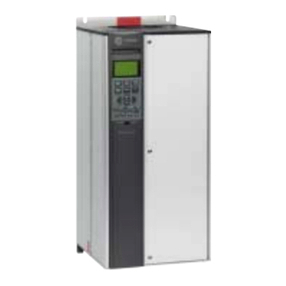
Trane
Trane TR1 6002 Installation and operation manual
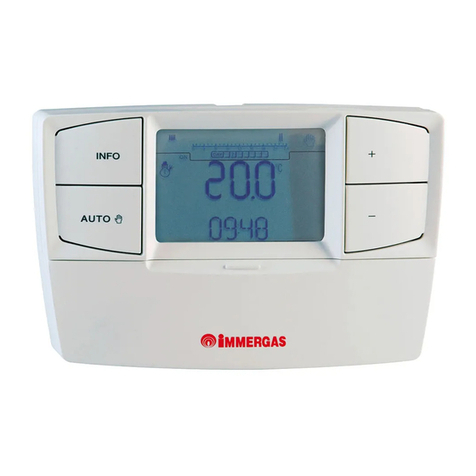
Immergas
Immergas CARV2 Instruction and warning book
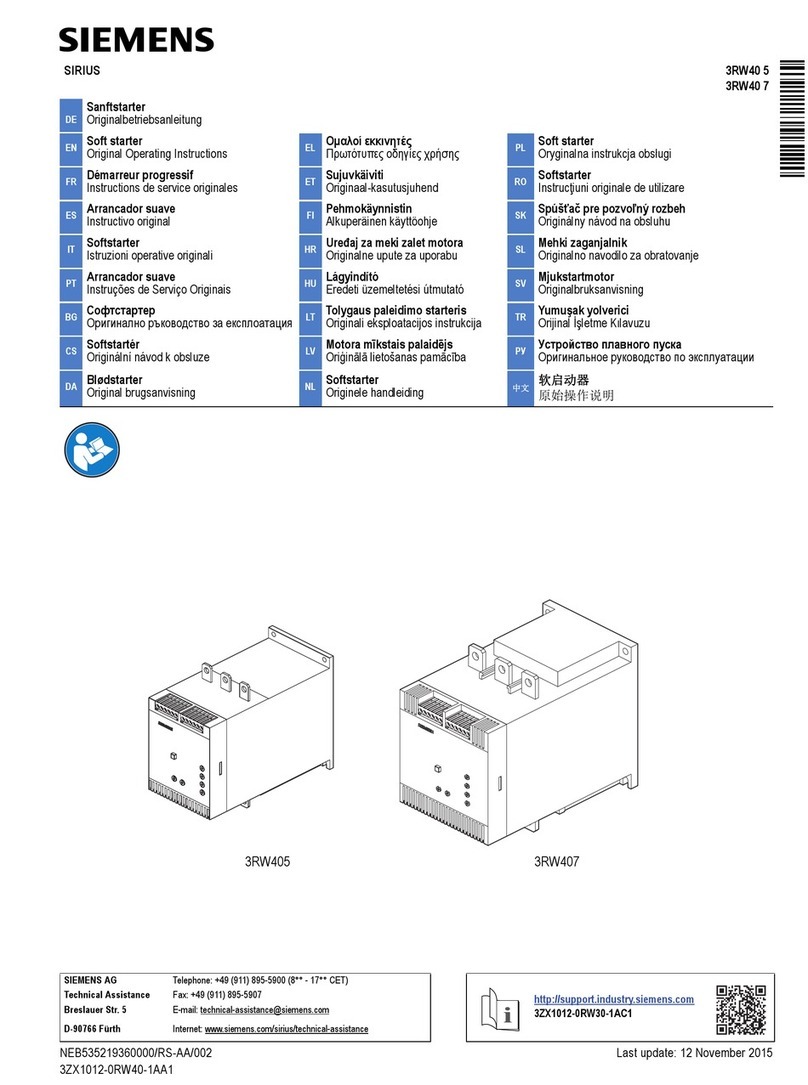
Siemens
Siemens SIRIUS 3RW40 5 Original operating instructions
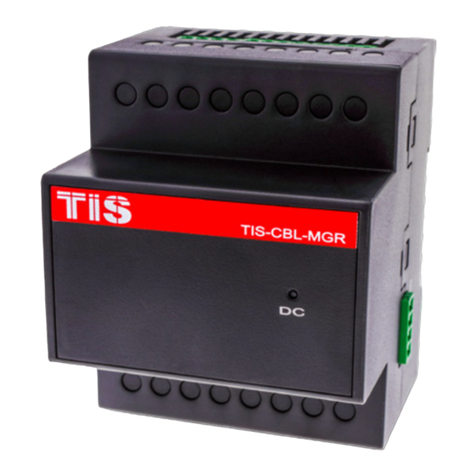
TIS
TIS TIS-CBL-MGR installation manual

Shimax
Shimax MAC3 Series instruction manual
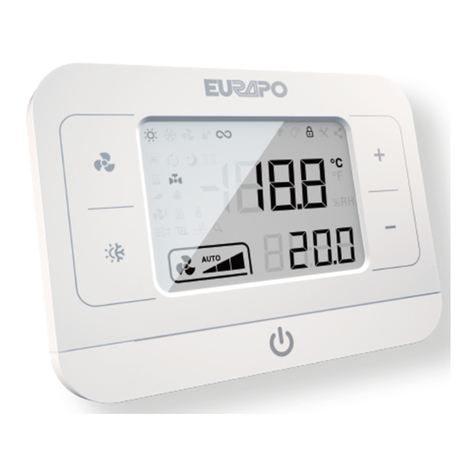
Eurapo
Eurapo OMNIBUS 360 MAINTENANCE and Operation manual
